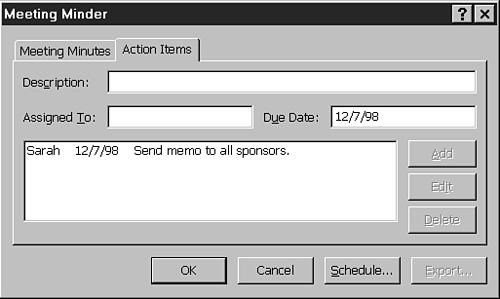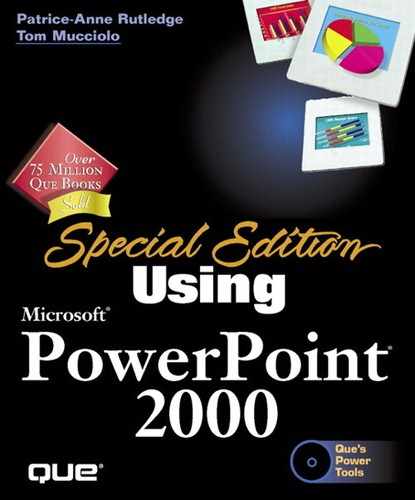Previewing Your Show
After you plan and set up your PowerPoint presentation, you should preview it. To do this, select Slide Show, View Show, or press F5. Figure 7.15 illustrates a sample slide show preview.
Figure 7.15. Preview your show to see what it will look like.

PowerPoint previews a show using the settings you enter in the Set Up Show dialog box. For example, you can preview in a browser or full screen, depending on what you entered in this dialog box. Whether you need to advance each slide manually also depends on your choices in this dialog box. How you navigate the presentation also depends on how you view it:
Full screen You'll preview full screen if you choose the Presented by a Speaker or the Browsed at a Kiosk option in the Set Up Show dialog box. The major difference between the two is that, when you present by a speaker, you have numerous navigation options available, because a person is in control of the presentation. When you browse at a kiosk, these navigation options aren't available, because this type of show is self-running.
Tip
If you set up your show to be browsed by an individual, you can view the presentation full screen by choosing Browse, Full Screen.
PowerPoint Browser You'll preview in the PowerPoint browser if you chose Browsed by an Individual in the Set Up Show dialog box. This browser is similar to other browsers such as Internet Explorer or Netscape Navigator. You can use the scrollbar to scroll through the presentation if it's available, or you can use the Page Up or Page Down keys to navigate manually.
Tip
Specify whether to display a scrollbar in the Set Up Show dialog box.
→ For more information about the Set Up Show dialog box, see "Setting Up a Show,"
Tip
To preview the show starting with the current slide, click the Slide Show button in the lower-left corner of the window.
Navigating a Show Full Screen
If you chose to present your PowerPoint slide show by a speaker, you'll display your presentation full screen. In this slide show type, you have several ways to advance each slide manually if you chose this method of advancing slides rather than by automatic timing.
You can left-click the mouse, press the spacebar, press the letter N, press the right arrow, press the down arrow, press the Page Down key, or press the Enter key. Table 7.1 lists other ways to navigate a slide show.
Tip
Right-click and choose Help from the menu to display this list of shortcuts within your presentation.
Note
The capability to toggle a black or white screen is a useful tool. For example, if you want to explain a detailed concept and want your audience to focus on what you're saying and not on the slide, you can temporarily make the screen either black or white. This is also useful during breaks for long presentations.
You have other ways to navigate a PowerPoint show. Right-click the mouse and from the Go menu you can choose any of the following navigational options:
Slide Navigator Displays the Slide Navigator dialog box (see Figure 7.16), in which you can choose the Show and the Slide title you w0ant to view. Simply select the slide you want and click the Go To button.
Note
The Show field is available only in presentations that include custom shows and enables you to choose the custom show that contains the slides you want to view.
Figure 7.16. The Slide Navigator dialog box helps you find slides.

By Title Displays a menu listing all slides in your presentation. Click the one you want to view.
Custom Show Displays a menu listing available custom shows. Click the one you want to view.
Previously Viewed Displays the previously viewed slide again.
Tip
Although these options are useful for finding a specific slide you want to display, you'll probably want to avoid using them during an actual presentation because a break in your flow can be distracting. One case in which you may want to use these features during a presentation would be when you have to go back to previous slides to answer questions or clarify a point and don't want to page through numerous slides to do so.
Setting Pointer Options
You can use an arrow pointer during a PowerPoint presentation, write with a pen, or hide all pointers. To choose these options, right-click the mouse, choose Pointer Options, and select Arrow, Pen, or Hidden from the menu that displays.
Figure 7.17 shows an arrow pointer. This is the standard type of pointer you're probably very familiar with.
Figure 7.17. Use a pointer during your slide presentation.

If you choose the pen option, you can make notes on your presentation as you deliver it. Figure 7.18 illustrates sample comments written with the pen.
Figure 7.18. Use a pen to add comments or illustrations to the presentation.

You can choose your pen color in the Set Up Show dialog box, or you can set it by right-clicking the mouse, choosing Pointer Options, and selecting a color from the list that displays.
→ To set up the pen color, see "Setting Up a Show,"
Tip
To erase your pen markings, right-click the mouse and choose Screen, Erase Pen, or press the letter E. Annotations are also erased when you advance to the next slide.
Using the Meeting Minder
With the Meeting Minder (p. 175), you can take meeting minutes, assign action items, and export these to Outlook and Word. To use the Meeting Minder, right-click the mouse and choose Meeting Minder. Figure 7.19 illustrates the Meeting Minder dialog box.
Figure 7.19. The Meeting Minder enables you to keep track of what happens during a meeting.

In the Meeting Minutes tab, you can enter detailed minutes from your presentation.
In the Action Items tab (see Figure 7.20), you can enter multiple action items for specific people.
Figure 7.20. Record action items in the Action Items tab.

To add an item, enter its Description, the name of the person to whom it's assigned, and a Due Date. Then click the Add button to add this item to action item list below.
Tip
You can also Edit and Delete selected action items by clicking these buttons.
To export the meeting minutes and action items to Outlook or Word, click the Export button. Figure 7.21 shows the Meeting Minder Export dialog box, which displays.
Figure 7.21. Export meeting minutes to Word or Outlook.

You can
Post Action Items to Microsoft Outlook
Send Meeting Minutes and Action Items to Microsoft Word
Choose either one or both options and click the Export Now button. Figure 7.22 shows a sample export to Microsoft Word.

You can't see the Post Action Items to Microsoft Outlook option? See the Troubleshooting section at the end of the chapter.
Click the Schedule button to open Outlook 2000 and display an appointment (see Figure 7.23).
Figure 7.23. You can post action items in Outlook 2000.

Note
If you haven't installed Microsoft Outlook, the Outlook 2000 Startup dialog box appears.
Click OK to exit the Meeting Minder. You'll notice that PowerPoint adds a slide that contains your recorded action items to the end of this presentation (see Figure 7.24).
Note
In addition to taking your own meeting minutes, you can also refer to your prewritten speaker's notes during your presentation. To do this, right-click the mouse and choose Speaker's Notes from the menu. The notes from the current slide display.
Figure 7.24. PowerPoint adds a slide summarizing your action items.


